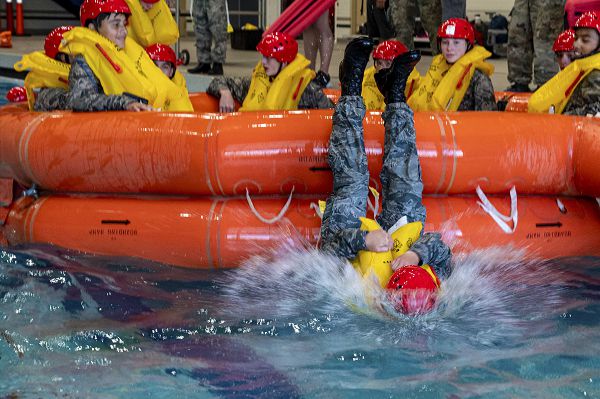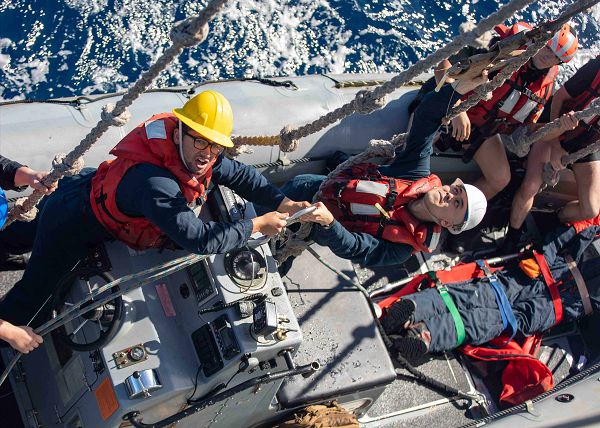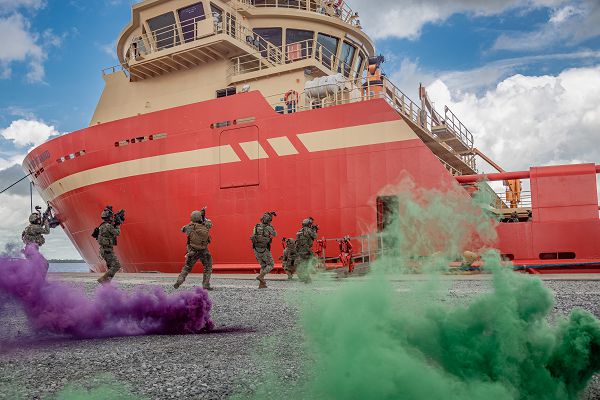- Details
- Hits: 436

Fairchild Air Force Base, Washington. (August 3, 2023): In this photo by Staff Sergeant David Phaff, Airmen from the 22nd Training Squadron teach water survival techniques to local Civil Air Patrol Cadets who came to learn to survive in austere environments. These brave young souls, some only 12 years old, volunteer their time and energy learning leadership, physical fitness, and character development in the Civil Air Patrol (CAP). The CAP is the official civilian auxiliary of the U.S. Air Force with stations in eight geographic regions including Puerto Rico and the District of Columbia.
Each year, the CAP attracts over 23,000 members ages 12 through 20 to its cadet programs that focus on four areas — leadership, aerospace, physical fitness, and character development.
Members must have a sincere interest in learning about aviation and the military and a desire to develop leadership skills in this year-round youth program.
- Details
- Hits: 431

Indian Ocean. (Aug. 4, 2023):In this photo by MC1 Ryre Arciaga, Boatswain's Mate 3rd Class Gabriel Schiazza, from San Diego, California, and Lieutenant Junior Grade Jay Hollister, from Marysville, Washington, connect a quick-release hook to a rigid-hull inflatable boat aboard the Ticonderoga-class guided-missile cruiser USS Antietam. The Antietam and her crew were taking part in Talisman Sabre 23, the largest bilateral military exercise between Australia and the United States of the year.
The Indian Ocean has been a critical trade route for centuries and currently accounts for one-third of the world's bulk cargo traffic and two-thirds of the world's oil shipments. Australia is the lynch pin for allied efforts to protect the free and open transit of these waters by commercial traffic. China has pursued what Beijing calls a “string of pearls” strategy to expand its influence in the Indian Ocean by building ports along its borders. Most of China’s oil flows through the Indian Ocean which is its primary access to Africa and the Middle East.
For these reasons, preventing China or Russia from dominating the Indian Ocean is essential to protecting western interests. To be ready for such a conflict, the U.S. and Australia conduct these annual Sabre exercises to ensure both nations can work together seamlessly should war break out.
- Details
- Hits: 487

Patrick Air Force Base, Florida. (August 8, 2023): In this photo by Staff Sergeant Darius Sostre-Miroir, Staff Sergeant Paul Bartholdson and Technical Sergeant Nathan Edwards, Rescue Riggers with the 920th Logistics Readiness Squadron, prepare to attach a reach pendant underneath a HH-60G Pave Hawk helicopter during sling load training. A sling load is used to transport a variety of cargo to remote, austere locations while suspended beneath the versatile Pave Hawk.
In 1981, the Air Force chose the Pave Hawk to replace the legendary Jolly Green Giant, the Air Force’s workhorse helicopter since the 1960s. Manufactured by Sikorski Aircraft, the Pave Hawk is a four blade, twin engine, medium lift chopper used primarily by special operations troops. Its missions include the insertion and recovery of special operations troops, combat search and rescue, and resupply of forces by air. They take on the most secretive and dangerous missions for the U.S. military.
The “Pave” is an upgraded communications and navigation suite that includes integrated inertial navigation/global positioning/Doppler navigation systems, satellite communications, and secure voice communications. The system allows the Pave Hawk to operate day or night and under severe weather conditions making it ideal for civil search and rescue and aeromedical evacuation.
The 920th Logistics Readiness Squadron provides supply, fuels, and transportation for warfighters preparing for deployment worldwide. The Squadron is comprised of Airmen who specialize in deployment planning, supply chain operations, and transportation management.
- Details
- Hits: 521

Norco, California. (August 1, 2023): In this photo by Neil Mabini, Tam Vo, an electrical engineer with the High Energy Laser and Metrology Lab at the Naval Surface Warfare Center, addresses local high school students participating in the Navy’s Science and Technology Education Partnership’s program. Nicknamed “STEM (Science, Technology, Engineering, and mathematics) in Defense,” this pilot program holds summer learning labs to give hands-on experience on career opportunities in the national defense field.
The Navy encourages students to pursue cybersecurity, data analytics, and the commercialization of military technology through outreach programs to area middle and high schools to get young students to become excited about pursuing careers in STEM.
Part of this educational outreach involves providing mentors and current engineering students from various disciplines in electrical, computer, mechanical, industrial and technology to individual students as they plan their future. The goal is to develop a new generation of workers and leaders who are grounded in the basic and applied sciences and can harness the increasingly complex technologies of tomorrow.
- Details
- Hits: 519

Great Lakes, Illinois. (August 1, 2023): In this photo by MC1 Luke McCall, Captain Craig Mattingly, commander of Naval Service Training Command, speaks to officer candidates during Naval ROTC New Student Indoctrination aboard the USS Marlinspike, a training ship at Recruit Training Command Great Lakes. The Naval ROTC program is a major contributor of new Naval officers through Navy ROTC offices at more than 160 colleges and universities across the country.
On the junior level, Navy ROTC and the National Defense Cadet Corps teach citizenship and civic responsibility through programs offered at more than six hundred high schools around the country.
The Naval Reserve Officers Training Corps (Navy ROTC) Program was established in 1926 to educate and train qualified young men and women for service as commissioned officers in the Naval Reserve or Marine Corps Reserve. As the largest single source of Navy and Marine Corps officers, the NROTC Scholarship Program fills a vital need in preparing mature young men and women for a career in today’s high-tech Navy and Marine Corps.
Applicants must pass a highly competitive national selection process and are awarded scholarships including tuition, books, and other financial benefits. Scholarship students make their own arrangements for college enrollment, like room and board, and they take the normal course load required by the university. They are also required to take several naval science courses in addition to their college's prescribed course load.
Upon graduation, NROTC Scholarship Program midshipmen are commissioned as ensigns in the Naval Reserve or second lieutenants in the Marine Corps Reserve and must serve up to an additional four years.
- Details
- Hits: 510

Georgetown, Guyana. (August 3, 2023): In this photo by Tech. Sergeant Brigette Waltermire, troops from Guyana, Mexico, Trinidad, and Tobago join U.S. forces to storm aboard a simulated “pirate” ship at a shore base during Tradewinds 23, a training event centering on human rights, anti-trafficking operations, and jungle warfare. During this two-week event, solders from Caribbean and Central American nations held jungle certification, marksmanship, and airborne wing exchanges in realistic training across Guyana. The exercise also included seminars on human rights, women, peace, and security in the Caribbean.
In its 38th year, Tradewinds 23 focuses on fighting organized crime, maritime interdiction of drugs, and battling human trafficking. This year’s event involved twenty-one nations and more than 1,500 people from all branches of the U.S. military, civilians, and law enforcement across partner nations.
U.S. military organizations that supported Tradewinds included Army and Air National Guard units from Alabama, Florida, Missouri, Oklahoma, and the Virgin Islands; U.S. Southern Command (SOUTHCOM); U.S. Army South; U.S. Marine Corps Forces South; Marine Forces Reserve, and the U.S. Coast Guard.


